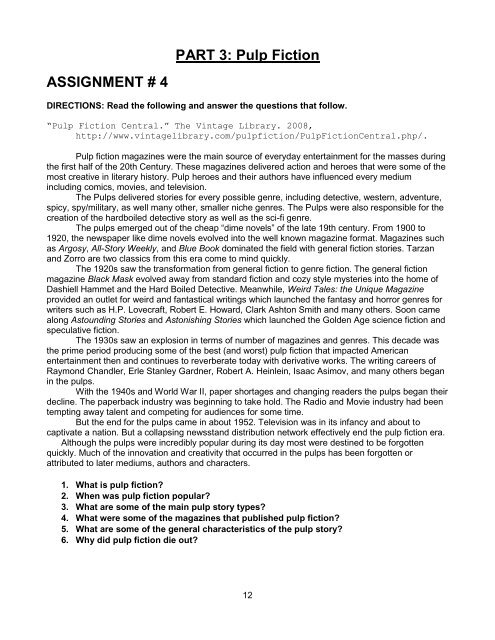Semester 2 Activities
Create successful ePaper yourself
Turn your PDF publications into a flip-book with our unique Google optimized e-Paper software.
PART 3: Pulp Fiction<br />
ASSIGNMENT # 4<br />
DIRECTIONS: Read the following and answer the questions that follow.<br />
“Pulp Fiction Central.” The Vintage Library. 2008,<br />
http://www.vintagelibrary.com/pulpfiction/PulpFictionCentral.php/.<br />
Pulp fiction magazines were the main source of everyday entertainment for the masses during<br />
the first half of the 20th Century. These magazines delivered action and heroes that were some of the<br />
most creative in literary history. Pulp heroes and their authors have influenced every medium<br />
including comics, movies, and television.<br />
The Pulps delivered stories for every possible genre, including detective, western, adventure,<br />
spicy, spy/military, as well many other, smaller niche genres. The Pulps were also responsible for the<br />
creation of the hardboiled detective story as well as the sci-fi genre.<br />
The pulps emerged out of the cheap “dime novels” of the late 19th century. From 1900 to<br />
1920, the newspaper like dime novels evolved into the well known magazine format. Magazines such<br />
as Argosy, All-Story Weekly, and Blue Book dominated the field with general fiction stories. Tarzan<br />
and Zorro are two classics from this era come to mind quickly.<br />
The 1920s saw the transformation from general fiction to genre fiction. The general fiction<br />
magazine Black Mask evolved away from standard fiction and cozy style mysteries into the home of<br />
Dashiell Hammet and the Hard Boiled Detective. Meanwhile, Weird Tales: the Unique Magazine<br />
provided an outlet for weird and fantastical writings which launched the fantasy and horror genres for<br />
writers such as H.P. Lovecraft, Robert E. Howard, Clark Ashton Smith and many others. Soon came<br />
along Astounding Stories and Astonishing Stories which launched the Golden Age science fiction and<br />
speculative fiction.<br />
The 1930s saw an explosion in terms of number of magazines and genres. This decade was<br />
the prime period producing some of the best (and worst) pulp fiction that impacted American<br />
entertainment then and continues to reverberate today with derivative works. The writing careers of<br />
Raymond Chandler, Erle Stanley Gardner, Robert A. Heinlein, Isaac Asimov, and many others began<br />
in the pulps.<br />
With the 1940s and World War II, paper shortages and changing readers the pulps began their<br />
decline. The paperback industry was beginning to take hold. The Radio and Movie industry had been<br />
tempting away talent and competing for audiences for some time.<br />
But the end for the pulps came in about 1952. Television was in its infancy and about to<br />
captivate a nation. But a collapsing newsstand distribution network effectively end the pulp fiction era.<br />
Although the pulps were incredibly popular during its day most were destined to be forgotten<br />
quickly. Much of the innovation and creativity that occurred in the pulps has been forgotten or<br />
attributed to later mediums, authors and characters.<br />
1. What is pulp fiction?<br />
2. When was pulp fiction popular?<br />
3. What are some of the main pulp story types?<br />
4. What were some of the magazines that published pulp fiction?<br />
5. What are some of the general characteristics of the pulp story?<br />
6. Why did pulp fiction die out?<br />
12




